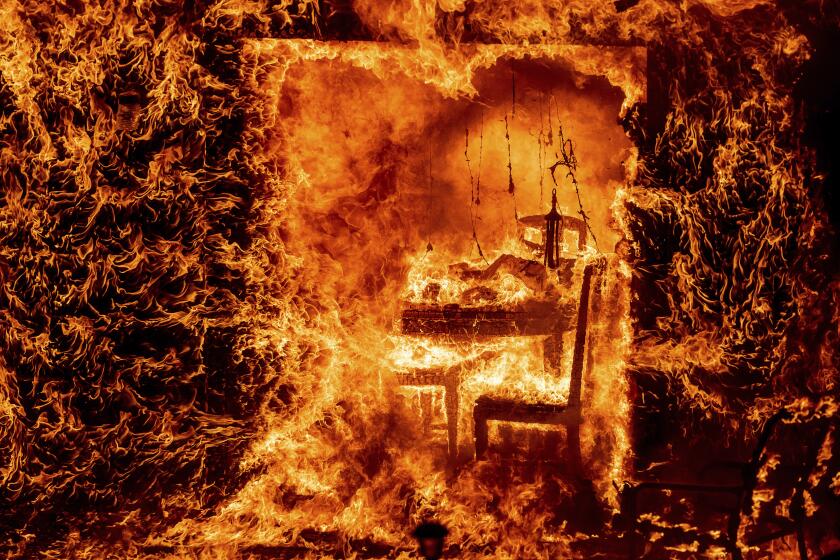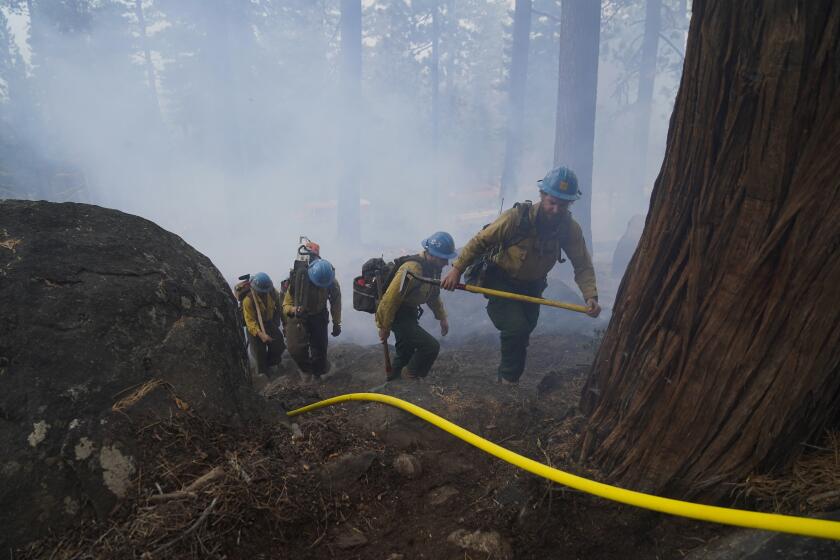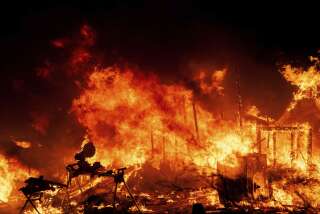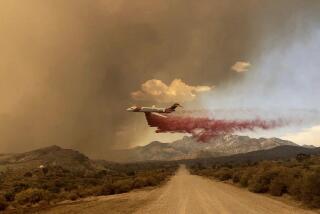Oak fire grows to 14,281 acres; Gov. Newsom declares state of emergency for Mariposa County

Firefighters were struggling to battle California’s largest fire of the season so far, a fast-moving inferno tearing through the Sierra Nevada foothills west of Yosemite National Park that has burned at least 10 structures, forced several thousand people to flee their homes and is threatening multiple mountain communities.
The Oak fire, which started Friday near Midpines and had spread to 14,281 acres as of 7 a.m. Sunday, marked an ominous start to the state’s peak wildfire season, with more dangerous blazes expected due to a combination of drought, climate change and overgrown vegetation that has increased the likelihood of fires igniting quickly and spreading rapidly.
It came as much of the globe was in the grip of extreme heat, with record-breaking temperatures fueling fires across Europe and prompting alerts in large swaths of the United States and China.
As the sun rose over the Sierra Nevada foothills, it appeared burnt orange through hazy skies in Mariposa County.
“The troops out on the ground have got a really tough situation right now to deal with,” said Kim Zagaris, former state fire and rescue chief for the California Governor’s Office of Emergency Services who now works as advisor for the Western Fire Chiefs Assn.
“Mother Nature throws a lot at us,” Zagaris said. “Aviation resources and the wildland community are stretched even thinner in today’s day and age — and not just us, but all across the world.”
More than 2,000 firefighters were battling the blaze. Gov. Gavin Newsom declared a state of emergency for Mariposa County on Saturday due to the effects of the Oak Fire. He said the state has secured a grant from the Federal Emergency Management Agency to help ensure the availability of vital resources to suppress the fire.
In the historic Yosemite-gateway town of Mariposa, Keisha McGruder, manager of the Bootjack Market & Deli, said the plumes of smoke coming off the raging fire early Sunday were so thick they were blowing into her store. Positioned about a quarter-mile from the blaze, McGruder said she’s staying open in spite of the conditions to make sure people get food and supplies they need to either hunker down or flee.
That group includes the crew of firefighters and emergency personnel that McGruder is offering free coffee and soft drinks to while they use her parking lot as a makeshift meeting place.
“We couldn’t even open the store yesterday. We had roads closed all the way to Highway 49 South … it was basically in our backyard,” said McGruder, who has lived in the area for more than three decades. “It’s pretty devastating up here.”
Sitting in her front yard Sunday morning while ash rained down on her, Beth Pratt was thankful that things weren’t worse. Less than a mile from the evacuation zone in Midpines, Pratt had packed up her car on Saturday ready to leave.
“The fire blew up,” said Pratt, 53, who is the California regional executive director for the National Wildlife Federation. “It looked like Godzilla over my house.”
But then firefighting air tankers began to arrive dumping retardant and tamping down the flames near her. Pratt cheered them from the ground. The planes haven’t stopped coming.
“Here I am in the middle of nowhere outside Yosemite,” she said. “But I feel like I’ve been under LAX the last couple of days.”
The blaze was one in a string of fires to hit the area in recent weeks. About seven miles to the southwest, the Agua fire burned 421 acres and destroyed three structures after it was sparked by a vehicle crash Monday. About 17 miles to the east, firefighters reported 79% containment of the Washburn fire burning in Yosemite National Park, having threatened a grove of giant sequoias and scorching 4,856 acres since July 7.
But those fires were rapidly outpaced by the Oak fire, which sent up a pyrocumulus cloud so large it could be seen from space and darkened skies with smoke for hundreds of miles, prompting air quality advisories as far away as Barstow and the Victor Valley. Its cause remains under investigation.
Mariposa residents and businesspeople kept a wary eye to the east as the familiar rhythms of evacuation returned.
“There’s a very ominous cloud of smoke over the hill,” said Aanthony Lerma, tour and volunteer director for the Mariposa Museum & Historical Center.
“I grew up here. I’m used to fires and procedures,” he said. “I’ve been evacuated a few times myself. I just pray that families over that way are safe.”
Lerma said he opened the museum Saturday morning for its president, a high school teacher, and his wife, who had to evacuate their home.
“They’re going to be camped out in the classroom today,” Lerma said. “They’re trying to stay safe and pray their house doesn’t burn down.”
An increase in catastrophic wildfires has reduced California tree cover by 6.7% since 1985, and researchers fear the lost trees will never grow back.
For evacuees, lodging in town was scarce, forcing many to head toward the valley.
“We’re full with evacuees,” said Alyssa Wildt, manager of the Mother Lode Lodge on Highway 49.
Wildt said many of the usual weekend tourists visiting Yosemite had canceled because of the fire, but the vacancies quickly filled with locals.
“Today we have a bunch of fire crews looking for rooms,” Wildt said. “We don’t have them. I believe most of town is full.”
Caleb Salas, manager of H&H Lumber, was on the job despite his home in Lushmeadows being under an evacuation order.
“Half my staff are out,” Salas said. “Who knows where they went — Clovis, Sonora.”
Salas said he thought his home was still safe, but he was worried about animals he’d had to leave behind: ducks, pigs and a cat that wouldn’t come to him.
“Once it’s shut down, you can’t go back,” he said.
The fire was reported around 2 p.m. Friday near Highway 140 and Carstens Road and quickly spread to the north, south and east at what officials described as a dangerous rate. It was being fueled primarily by dense, dry vegetation and fanned by steep terrain, officials said.
Parts of the Central Valley have endured 13 consecutive days of triple-digit heat, although temperatures in the low to mid-90s prevailed in the higher-elevation area where the fire started, said Felix Castro, meteorologist with the National Weather Service in Hanford.
The air was very dry, with a relative humidity of 8% or 9%, and that combined with the ongoing extreme drought meant vegetation had reached near-record dryness, he said. A recent study found this to be the driest 22-year period in at least 1,200 years and concluded the conditions have been intensified by temperatures sent rising due to greenhouse gasses accumulating in the atmosphere.
“Our drought indices are about as low as they can get, including the last two to three years, for much of our region, with the greatest dryness in the Sierra,” Castro said.
A federal firefighter’s viral resignation letter is highlighting the job’s low pay and harsh working conditions in the age of climate change.
Flames chewed through parched grass, brush and woodland oak, advancing into timber stands littered with conifers killed by both drought and bark beetle infestations, to which drought-weakened trees are more susceptible, fire officials said. These dead conifers tend to carpet the ground with needles and are more likely to fall over both before and during fires, helping to carry flames higher up into canopies and posing a risk to firefighters, Zagaris said.
The dry, dead trees are particularly combustible and release large amounts of energy as they burn, stoking the massive cloud of smoke and ash that could be seen for miles over the fire, he said. Such clouds are capable of making their own weather.
“When you get a pyrocumulus column, it can pick up a pretty good-sized branch and actually draw it aloft into the column and in some cases drop it a mile or two miles down the head of the fire, which starts additional spot fires,” Zagaris said.
These columns eventually collapse, dropping air and debris instead of sucking them up, spreading flames in all directions and creating dangerous conditions for personnel on the ground, he said.
Firefighters on Saturday were “dealing with explosive fire activity,” said Natasha Fouts, public information officer with the California Department of Forestry and Fire Protection. That included long-range spotting, in which embers are hurled miles ahead of the fire, as well as area ignition, in which swaths of land go up in flames after the embers land in dry fuel beds, she said. About 403 personnel were assigned to the blaze, with more on the way, Fouts said. They were chiefly focused on protecting structures and getting fire lines established, she said.
The fire was threatening the communities of Lushmeadows, Midpines, Jerseydale and Bootjack, from which about 6,062 people had been evacuated as of Saturday afternoon, officials said. No injuries had been reported, although at least 10 structures had been destroyed and another 2,000 were threatened. Gov. Gavin Newsom proclaimed a state of emergency in the county.
The fire’s rapid progression in its first hours forced officials to move an evacuation center from the New Life Christian Fellowship church, which had been used in prior fires, to Mariposa Elementary School.
By noon Saturday, more than 60 people had checked in to the evacuation center at the school, said Taylor Poisall, spokeswoman for the American Red Cross of Central California.
Beds with privacy screens were set up in the school cafeteria and three daily meals are being served, Poisall said. A pet shelter was also opened at the school by the Central California Animal Disaster Team.
“We had a lot of people evacuate last night with their animals,” Poisall said. “Animals are family too.”
Climate change, drought and soaring temperatures are setting the stage for another devastating wildfire season, officials say.
Emmanuel Scudder and his son-in-law Israel Lopez were driving to a Christian men’s conference in San Jose on Friday afternoon when his wife, Jaimie, called to tell him she had received a fire warning from Mariposa County.
It did not seem threatening then, but half an hour later she called back.
“Turn your butts around,” she told him. “We have to get the animals.”
Scudder, a chaplain for the nonprofit Merced County Jail Ministry, arrived at his home in Bootjack 2 ½ hours later to find that his wife and a friend had corralled the four dogs and three of the cats. The barn cat was missing.
“I called the Sheriff’s Department last night,” Scudder said. “They said they would get somebody on it.”
They did.
“The firemen found our fourth cat and let us know today,” he said.
Scudder is now staying at the evacuee center with the two large dogs. The rest of the family and pets have gone to stay in Tracy, he said.
Of the house, he has no information.
“As of last night they saved it,” he said. Since 8 a.m. Saturday he has not had an update.
“I’m glad everyone in our family is safe and the animals are safe,” he said. “The property we can replace.”
More to Read
Start your day right
Sign up for Essential California for news, features and recommendations from the L.A. Times and beyond in your inbox six days a week.
You may occasionally receive promotional content from the Los Angeles Times.














